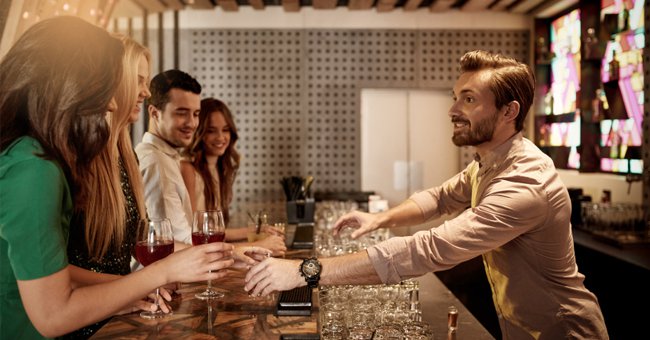The real star of any bar is the bartender. Innovative cocktails with fresh ingredients might get people in the door, but a bartender with a sparkling personality keeps them coming back. The making of a great bartender is part mixologist, part social scientist, part salesperson. But even if that kind of charm doesn’t come naturally to you, there’s still hope.
Dale DeGroff spent 12 years at the helm of New York City’s legendary Rainbow Room, where he reinvented the concept of cocktails in the 1980s. He credits a large part of his success to his customer connection skills. In fact, DeGroff’s likability is legendary both within the cocktail industry and beyond it. “There is absolutely a connection between the success of mixology and the personalities in it,” he says.
DeGroff’s number one tip to his students in his annual bartender bootcamp: “Eye contact. When people come into your space, you have a window of a couple of minutes to make eye contact and smile. There are bars on every block in New York City, so if people don’t feel like they’re being treated the way they want to be treated, they’ll just go somewhere else.”
Acknowledging the customer is crucial, even if you aren’t able to serve her right away. Rookie bartenders might think that ignoring someone until they can make her drink makes them seem more attentive in the long run, but customers can sense when they’ve been seen and ignored.
“A bartender should nod and put you on the line. The idea is for the bartender to notice who comes in and to subconsciously make a checklist of who needs what, while giving the person a smile and a wave and a hello,” advises DeGroff. “This is a critical and difficult thing for young bartenders, who get wrapped up in remembering how to make drinks. They should be surveying their domain.”
Nicholas Bennett, a 13-year bartending veteran, agrees. “The first thing a guest wants when they step into a bar is to be acknowledged. No matter how busy you are, as long as you’ve accomplished that you’ve already developed a rapport.” Bennett currently works as the head bartender at Porchlight, the latest creative property from the Union Square Hospitality Group in New York.
Bonding with guests doesn’t start and stop at first impressions. Even that ubiquitous, inevitable question (“What can I get you?”) can be an opportunity to bond.
“There are lots of fun and quick games you can play that win people over. I like to ask, ‘So what do you usually drink? Oh really, you like rum? Have I got a drink you should try,’” says DeGroff. “Or if I have a customer who doesn’t like gin, I make it a challenge to come up with a gin drink they like – and if they don’t like it, they don’t have to pay for it.”
Joaquín Simó, the co-owner and head mixologist of Pouring Ribbons and the 2012 American Bartender of the Year winner, suggests building trust with your customers over drink suggestions.
“Read your guests and listen to what they’re saying instead of trying to ‘teach them’ how to ‘drink better.’ Make them the best Cosmo they’ve ever had, then maybe you’ve earned just enough trust from them to recommend a Southside or Queens Park Swizzle,” says Simó.
“Craft cocktail bartenders sometimes think that the drinks that they themselves enjoy the most are the ones that they should serve to their guests. A tiny percentage of bar guests might be into a room-temperature serve consisting of two overproof spirits and three amari, but most would probably be way happier with a Tom Collins or a Manhattan,” Simó warns.
A great bartender is well-rounded. If your bar doesn’t have a lot of regulars or you live in fear of failing to strike up a conversation, cover your bases by diversifying your interests. When it comes to polite conversation, it’s better to be a jack of all trades than a master of one. One surefire way to accomplish this?
“Read. Read newspapers, weekly local magazines, blogs, books, national publications and just about anything you can get your hands on. You don’t need to be an expert on everything, but if you know just enough about a variety of topics, your odds of being able to ask your guest an intelligent question about a topic they are interested in has increased exponentially,” advises Simó.
Bennett agrees: “Read the newspaper. Even skimming the headlines of the sports section can help. This keeps you up to date with current events and allows you to be part of more conversations.”
You never know who might walk into your bar. If you run into someone who loves obscure topics you can’t chat about, take it as an opportunity to ask questions.
“If you don’t know anything about a topic, then that frees you up to ask questions about it. A little disagreement never hurts — and can, in fact, drive a conversation. As long as you remain non-confrontational, then you can transition the conversation into a discussion,” says Bennett.
“Just about everyone loves getting asked a question about something they feel passionately about. It could be Game of Thrones or that Pluto might be a planet after all. One leading question may bring you closer to your guests than anything that comes out of a mixing glass,” says Simó.
A bartender’s identity often gets wrapped up into the bar as a whole in people’s minds, but that can benefit both you and your establishment. Aside from passing the time, the point of building relationships with your visitors – on any scale – is for them to see you as a memorable presence in the bar. This leads to repeat customers and the best form of advertising: word of mouth recommendations.
“No matter how busy it gets, the important thing is to retain confidence and control. You have to project to the guests that there’s a certain amount of relaxation in what you’re doing, that you’re good at it and that you enjoy your job,” explains DeGroff.
“Be proud of what you’re serving. You’ve got to be a company person. You work for the house,” he adds.
“Ultimately it’s always about the guest and ensuring they are getting the service experience they need at that moment. It’s our responsibility to ascertain whether a guest needs to be talked to, or whether they want to do the talking. Sometimes, you go to a bar to be left alone and sometimes you go to a bar to meet people. There’s no one right way to make everyone comfortable,” says Simó.
Connecting with guests is a lot like mixology, as it turns out. There are some basics, some surprising discoveries, and some best practices – but in the long run, you have to experiment with tactics to see what works.




